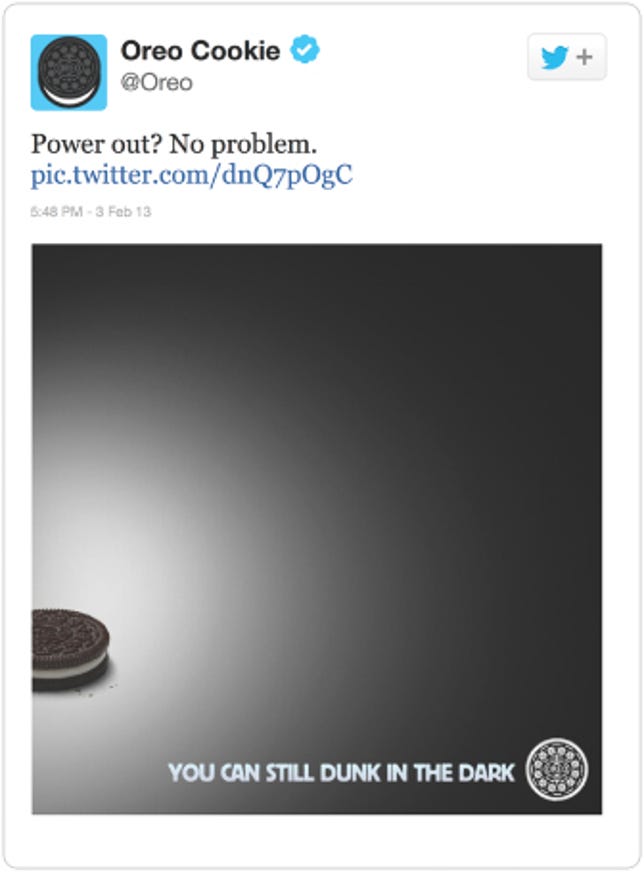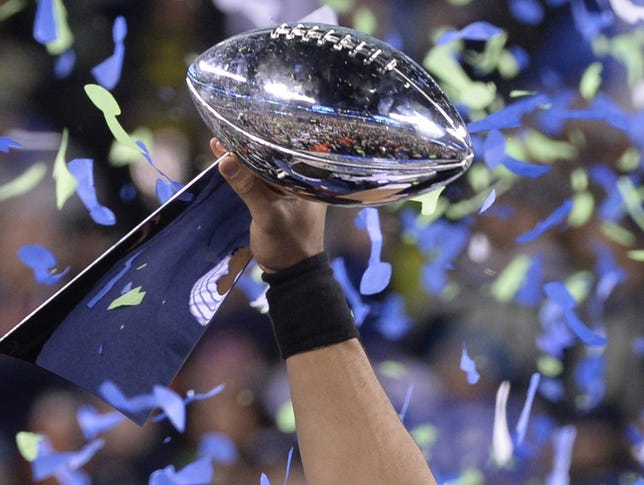
Twitter/@Oreo
It all started with a tweet about an Oreo.
When the Super Bowl stadium experienced a blackout in the middle of last year’s game, Oreo sent a tweet to capitalize on the unfortunate turn of events.
“Power out? No problem,” the tweet read, along with an ad showing an Oreo and the tagline, “You can still dunk in the dark.”
The tweet was retweeted 15,643 times and became a symbol of the marketing power of social media. In addition to receiving kudos for a clever way to draw attention from the biggest live event of the year, it set a new bar for the advertising industry. There’s a good chance social media will be an even bigger part of your game-watching experience this Sunday.
“There’s a competitiveness to have that social-listening campaign and create that piece of ‘Oreo’ content that everyone starts talking about,” said Michelle Barna-Stern, director of social media communications for marketing agency Deep Focus. “Trying to shift that conversation, at least for a moment, from the Super Bowl to your brand is everyone’s hope.”
Super Bowl ads have long become their own kind of spectacle, with viewers ready to be dazzled by what advertisers will air to millions of viewers during the big game. Now, that marketing focus has extended beyond the television set as brands ramp up viewer engagement with tweets and other social campaigns.
Last year, advertisers got six times the social mentions on the day of the game. Facebook reported 50 million people talking about the event on its social network, while Twitter reported more than 24.1 million tweets about the game, the ads and the halftime show. And with TV ads costing $4.5 million for 30-second slots this year, a social media campaign can be considerably cheaper.


Timothy A. Clary/AFP/Getty Images
Marketers’ focus on social media can be traced to 2012, when the NFL established its first social media command center to monitor tweets and posts during the game, said Barna-Stern. With that, brands could no longer ignore the use of services like Twitter and Facebook to talk to potential customers, she said.
Facebook is taking advantage of its increased profile during the Super Bowl by launching a real-time hub to match the speed of Twitter’s tweets. Volvo is skipping a splashy TV ad and running a Twitter contest for a chance to win a car. The automaker is also paying for promoted tweets: Automatically inserting a Volvo ad into the feeds of users following any of Volvo’s competitors.
Web hosting company GoDaddy.com last week saw the power of social media — but not in the way it wanted. The company known for its ads featuring semi-clothed women previewed a new ad about a lost puppy that, after finding its way back home, gets sold on a site created using GoDaddy’s service. GoDaddy received a flood of disapproving tweets, and prompted the company to pull its ad.
There’s a lot of opportunity for companies to attract attention. Nearly half of smartphone and tablet owners are likely to use apps while they are watching the game. And one-third of those surfing their devices will be checking out their social media feeds, according to a survey conducted by analytics company SOASTA.
“You have people all over the globe speaking about this one game, all eyes are on this one game,” Barna-Stern said. “It is a tremendous, tremendous deal.”




